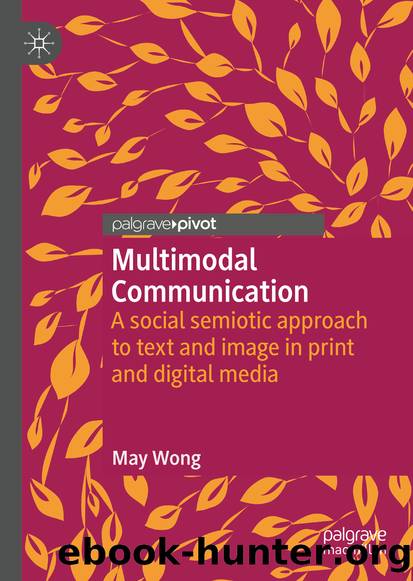Multimodal Communication by May Wong

Author:May Wong
Language: eng
Format: epub
ISBN: 9783030154288
Publisher: Springer International Publishing
4.4 Hybridity in Branding Strategies and Its Impact on Viewer Engagement
As noted above, the engagement strategies deployed in personal loan TV advertisements are quite straightforward: the advertisers attribute their claims to intertextual characters and discourses and the intertextual voices endorse the advertisersâ claims through the engagement system laid down in Martin and White (2005). Under Feng and Wignellâs system of engagement values, the two personal loan TV adverts under scrutiny in the preceding section should be considered as highly engaging in the sense that the plot involving both the characters and their lifelike situations entailing a direct, personalised and private dialogue among the intertextual voices becomes an inseparable part of the advertisement.
On the other hand, most advertisements in my data, including the two adverts to be considered in this section, are less engaging. The degree of recontextualisation (and thus the engagement value) is median as there is usually a distinct episode of service pledges at the end of the ad. In this sense, the character voices and the appropriated social practices merely provide a âcontext of situationâ for introducing the loan service and appealing to the consumers (rather than the characters in the ads) emotionally, and then the seller voice takes over the job to highlight rational factors of using the service. This is unlike the two highly engaging adverts discussed in Sect. 4.3 where the intertextual voices speak for the service itself. Yet, median engagement value of advertising does not mean that intertextual voices are neutralised; they undoubtedly endorse the advertised service, albeit through other means such as rhetorical structure . Two principal kinds of rhetorical structure will be discussed in this section: the first draws on a warrant offered recurrently by most adverts that the product/service is a solution to a problem (Cook 2001: 49; Dyer 1982: 168â169), while the second comes from the fundamental structure of narratives, which is âdream come trueââit functions on the level of a day-dream/fantasy that viewers are able to make those desires that remain unsatisfied in their everyday life come true on the condition that they sign up to the loan service (OâHalloran et al. 2013; Vestergaard and Schroder 1985: 117). In the following, a detailed analysis of these two kinds of rhetorical structure will be provided using two additional examples of personal loan advertising. The aim is to prove that emotional branding with either the âproblem-solutionâ or âdream come trueâ rhetorical structure can be combined with rational branding in terms of direct propaganda in the advertising of personal loan services, and to demonstrate that such kind of hybridity may have an impact on the strategies of viewer engagement.
The first example (see Table 4.4) recontextualises a familiar social practice (âshopping in a storeâ) and uses a problem-solution pattern to endorse the loan service. The narrative structure (orientation^complication^resolution) is beginning to emerge (see Martin and Plum 1997) as the story unfolds. The story is that the young couple browse in a furniture store (orientation) and suddenly realise that they are short of money to purchase all the household items they need (complication).
Download
This site does not store any files on its server. We only index and link to content provided by other sites. Please contact the content providers to delete copyright contents if any and email us, we'll remove relevant links or contents immediately.
| Anthropology | Archaeology |
| Philosophy | Politics & Government |
| Social Sciences | Sociology |
| Women's Studies |
Cecilia; Or, Memoirs of an Heiress — Volume 1 by Fanny Burney(32434)
Cecilia; Or, Memoirs of an Heiress — Volume 2 by Fanny Burney(31871)
Cecilia; Or, Memoirs of an Heiress — Volume 3 by Fanny Burney(31854)
The Great Music City by Andrea Baker(31349)
We're Going to Need More Wine by Gabrielle Union(18967)
All the Missing Girls by Megan Miranda(15571)
Pimp by Iceberg Slim(14394)
Bombshells: Glamour Girls of a Lifetime by Sullivan Steve(13973)
Talking to Strangers by Malcolm Gladwell(13222)
Norse Mythology by Gaiman Neil(13206)
Fifty Shades Freed by E L James(13157)
For the Love of Europe by Rick Steves(12992)
Mindhunter: Inside the FBI's Elite Serial Crime Unit by John E. Douglas & Mark Olshaker(9201)
Crazy Rich Asians by Kevin Kwan(9167)
The Lost Art of Listening by Michael P. Nichols(7406)
Enlightenment Now: The Case for Reason, Science, Humanism, and Progress by Steven Pinker(7235)
The Four Agreements by Don Miguel Ruiz(6631)
Bad Blood by John Carreyrou(6552)
Weapons of Math Destruction by Cathy O'Neil(6146)
